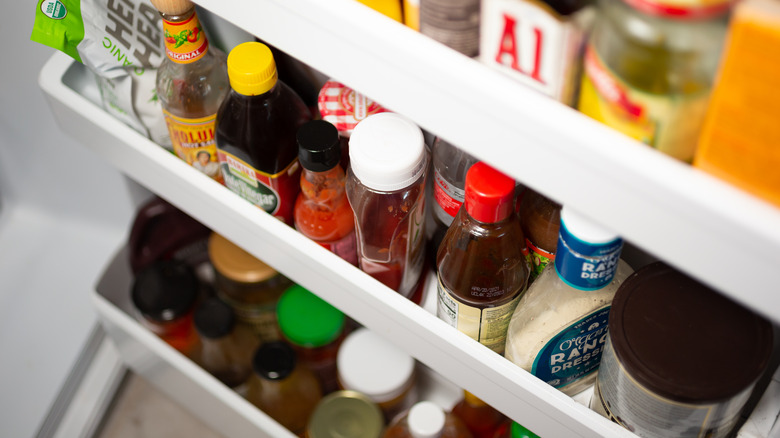The Type Of Condiments You Should Always Refrigerate
If you love to cook, it can feel like the condiments and sauces needed to make a wide range of dishes are taking over the refrigerator, leaving little room for other essential ingredients like milk and butter. So, what's a person to do about the miscellaneous bottles of mayonnaise (regular and spicy), ketchup (original and Sriracha flavored), red curry paste, and not to forget the huge assortment of mustards? Some are used frequently like soy sauce while others (wasabi paste) are kept on hand for the day you need a little extra kick for a meal.
First off, it's best to keep the condiments in the right place in the fridge so they are easy to access when you want them. Place the jars and bottles of condiments in the shallow shelves on the refrigerator's door for storage. The shelves prove to be a great size for the containers and allow for good accessibility when you want to quickly grab a little mustard for a sandwich. Compared to other items in your refrigerator, condiments do better with temperature changes, which often occurs as fridge doors are opened and closed, according to Eating Well. No one-size-fits-all approach applies for how long condiments will last, so Reader's Digest advises to pay attention to the best-by date on each bottle. Their expiration dates range from about four months after opening for barbecue sauce to two years after opening for gochujang.
Refrigerate dairy-based items
There is one category of food items that always need to be stored in the refrigerator: items containing dairy, according to WebMD. Think sour cream and some fresh salad dressings or sauces containing cream or yogurt (via Today). Mayo, made with eggs, also needs a spot in the fridge after opening to stop bacteria from growing, says Huffington Post. However, these items need to go on the shelves in your refrigerator, and not on the door, because they are not able to handle the temperature fluctuations of the door's shelves as well. If stored properly, dairy-based condiments can last for days to weeks, depending on what the item is, per United States Department of Agriculture (USDA).
Some signs to tell if your sour cream has gone bad is its smell has changed and it its color has changed or mold is starting to grow. For products that are mayo-based, like salad dressings, look for separation of the ingredients. The best rule to follow is if the grocery store kept it in the cooler, then you should keep it in your refrigerator when you get home and always keep an eye on the best-by-date.

